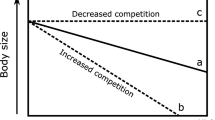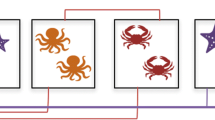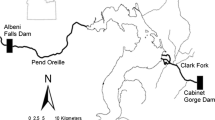Abstract
Asymmetrical interspecific competition among top predators can indirectly affect the predation risk for their prey by altering the abundance, diet, and habitat use of inferior competitors. However, the indirect effects of such biological interactions are poorly known because of the difficulties in measuring predation risk in nature. We addressed this issue by assessing the effect of asymmetrical competition among brook trout (Salvelinus fontinalis) and two superior non-piscivorous competitors, creek chub (Semotilus atromaculatus) and white sucker (Catostomus commersonii), on the predation risk of a brook trout prey, northern redbelly dace (Chrosomus eos). We determined the spatio-temporal patterns of relative predation risk of dace with tethering experiments in 11 lakes containing either only brook trout and dace (n = 5), or brook trout, dace, chub, and sucker (n = 6). The diel pattern of the relative predation risk and the overall relative predation risk of dace were not significantly different in lakes with or without brook trout competitors. However, we observed a significant shift in the relative predation risk from the lower pelagic to the upper pelagic and littoral zones in the presence of brook trout competitors. This study highlights the fact that the outcome of interactions can vary in space and that care should be used when extrapolating the results of small-scale experiments or coarse-scale estimates to the whole ecosystem.


Similar content being viewed by others
References
Amarasekare P (2003) Competitive coexistence in spatially structured environments: a synthesis. Ecol Lett 6:1109–1122
Aronson RB, Heck KL Jr (1995) Tethering experiments and hypothesis testing in ecology. Mar Ecol Prog Ser 121:307–309
Aronson RB, Heck KL Jr, Valentine JF (2001) Measuring predation with tethering experiments. Mar Ecol Prog Ser 214:311–312
Bertolo A, Pépino M, Adams J, Magnan P (2011) Behavioural thermoregulatory tactics in lacustrine brook charr, Salvelinus fontinalis. PLoS One 6:e18603
Bourke P, Magnan P, Rodríguez MA (1996) Diel locomotor activity of brook charr, as determined by radiotelemetry. J Fish Biol 49:1174–1185
Bourke P, Magnan P, Rodríguez MA (1999) Phenotypic responses of lacustrine brook charr in relation to the intensity of interspecific competition. Evol Ecol 13:19–31
Brewer DT, Blaber SJM, Salini JP, Farmer MJ (1995) Feeding ecology of predatory fishes from Groote Eylandt in the Gulf of Carpentaria, Australia, with special reference to predation on penaeid prawns. Estuar Coast Shelf Sci 40:577–600
Burnham KP, Anderson DR (2002) Model selection and multimodel inference: a practical information-theoretic approach, 2nd edn. Springer, New York
Chase JM, Abrams PA, Grover JP, Diehl S, Chesson P, Holt RD, Richards SA, Nisbet RM, Case TJ (2002) The interaction between predation and competition: a review and synthesis. Ecol Lett 5:302–315
Clark CW, Levy DA (1988) Diel vertical migration by juvenile sockeye salmon and the antipredation window. Am Nat 131:271–290
Cox DR, Oakes D (1984) Analysis of survival data. Chapman & Hall/CRC, Boca Raton
Danilowicz BS, Sale PF (1999) Relative intensity of predation on the French grunt, Haemulon flavolineatum, during diurnal, dusk, and nocturnal periods on a coral reef. Mar Biol 133:337–343
Dupuch A, Magnan P, Bertolo A (2009a) Does predation risk influence habitat use by northern redbelly dace Phoxinus eos at different spatial scales? J Fish Biol 79:1371–1382
Dupuch A, Dill LM, Magnan P (2009b) Testing the effects of inherent habitat riskiness and resource distribution on the simultaneous habitat selection of predators and prey. Anim Behav 78:705–713
East P, Magnan P (1991) Some factors regulating piscivory of brook trout, Salvelinus fontinalis, in lakes of the Laurentian Shield. Can J Fish Aquat Sci 48:1735–1743
Englund G, Cooper SD (2003) Scale effects and extrapolation in ecological experiments. Adv Ecol Res 33:161–213
Gaudreau N, Boisclair D (1998) The influence of spatial heterogeneity on the study of fish horizontal daily migration. Fish Res 35:65–73
Gauthier S, Boisclair D, Legendre P (1997) Evaluation of a variable angle scanning method to estimate relative abundance and distribution of fish using a single-beam echo sounder in shallow lakes. J Fish Biol 50:208–221
Gilliam JF, Fraser DF (1987) Habitat selection under predation hazard: test of a model with foraging minnows. Ecology 68:1856–1862
Goyer K, Bertolo A, Pepino M, Magnan P (2014) Effects of lake warming on behavioural thermoregulatory tactics in a cold-water stenothermic fish. PLoS One. doi:10.1371/journal.pone.0092514
Kronfeld-Schor N, Dayan T (2003) Partitioning of time as an ecological resource. Ann Rev Ecol Evol Syst 34:153–181
Lacasse S, Magnan P (1992) Biotic and abiotic determinants of the diet of brook trout, Salvelinus fontinalis, in lakes of the Laurentian Shield. Can J Fish Aquat Sci 49:1001–1009
Magnan P (1988) Interactions between brook charr, Salvelinus fontinalis, and non salmonid species: ecological shift, morphological shift, and their impact on zooplankton communities. Can J Fish Aquat Sci 45:999–1009
Magnan P, FitzGerald GJ (1982) Resource partitioning between brook trout (Salvelinus fontinalis Mitchill) and creek chub (Semotilus atromaculatus Mitchill) in selected oligotrophic lakes of southern Quebec. Can J Zool 60:1612–1617
Magnan P, FitzGerald GJ (1984a) Mechanisms responsible for the niche shift of brook charr, Salvelinus fontinalis Mitchill, when living sympatrically with creek chub, Semotilus atromaculatus Mitchill. Can J Zool 62:1548–1555
Magnan P, FitzGerald GJ (1984b) Ontogenic changes in diel activity, food habits and spatial distribution of juvenile and adult creek chub, Semotilus atromaculatus. Environ Biol Fish 11:301–307
Magnan P, Rodríguez MA, Legendre P, Lacasse S (1994) Dietary variation in a freshwater fish species: relative contributions of biotic interactions, abiotic factors, and spatial structure. Can J Fish Aquat Sci 51:2856–2865
Magnan P, Proulx R, Plante M (2005) Integrating the effects of fish exploitation and interspecific competition into current life history theories: an example with lacustrine brook trout (Salvelinus fontinalis) populations. Can J Fish Aquat Sci 62:747–757
Naud M, Magnan P (1988) Diel onshore-offshore migrations in northern redbelly dace, Phoxinus eos (Cope), in relation to prey distribution in a small oligotrophic lake. Can J Zool 66:1249–1253
Persson L, de Roos A (2013) Symmetry breaking in ecological systems through different energy efficiencies of juveniles and adults. Ecology 94:1487–1498
Persson A, Hansson LA (1999) Diet shift in fish following competitive release. Can J Fish Aquat Sci 56:70–78
Post JR, Parkinson EA, Johnston NT (1998) Spatial and temporal variation in risk to piscivory of age-0 rainbow trout: patterns and population level consequences. Trans Am Fish Soc 127:932–942
Power G (1980) The brook charr, Salvelinus fontinalis. In: Balon EK (ed) Charrs, salmonid fishes of the genus Salvelinus. Dr. W. Junk, The Hague, pp 141–203
Quinn GP, Keough MJ (2002) Experimental design and data analysis for biologists. Cambridge University Press, New York
Robertson DR (1996) Interspecific competition controls abundance and habitat use of territorial Caribbean damselfishes. Ecology 77:885–899
Schoener TW (1983) Field experiments of interspecific competition. Am Nat 122:240–285
Scott WB, Crossman EJ (1974) Poissons d’eau douce du Canada. Bulletin 184. Office de recherches sur les pêcheries du Canada
Skelly DK (2002) Experimental venue and estimation of interaction strength. Ecology 83:2097–2101
Strange RM, Mayden RL (2009) Phylogenetic relationships and a revised taxonomy for North American cyprinids currently assigned to Phoxinus (Actinopterygii: Cyprinidae). Copeia 2009:494–501
Taylor BW, McIntosh AR, Peckarsky BL (2002) Reach-scale manipulations show invertebrate grazers depress algal resources in streams. Limnol Oceanogr 47:893–899
Tremblay S, Magnan P (1991) Interactions between two distantly related species, brook trout (Salvelinus fontinalis) and white sucker (Catostomus commersonii). Can J Fish Aquat Sci 48:857–867
Werner EE, Hall DJ (1977) Competition and habitat shift in two sunfishes (Centrarchidae). Ecology 58:869–876
Wootton JT, Emmerson M (2005) Measurement of interaction strength in nature. Ann Rev Ecol Evol Syst 36:419–444
Acknowledgments
We thank Julie Adams, Maryse Blanchette, Come Garceau, Annie Jacob, Kathy-Andrée Laplante-Albert, Maxime Léveillé, Rachel Massicotte, Aurore Perot, Daniel Pouliot, Raphaël Proulx, Evelyne Roy, and Sylvain Theleme for their assistance at various stages of this research as well as Daniel Boisclair, Laure Devine, and Jim Grant for their comments on earlier versions of this paper. We also thank the Société des Etablissements de Plein Air au Québec for logistical support and Peter Sale for giving us information about building the chronographic tether. This research was supported by a grant from the Natural Sciences and Engineering Research Council of Canada and the Canada Research Chair Program to P. Magnan. The protocol of this research was approved by the Animal Care Committee of the Université du Québec à Trois-Rivières.
Author information
Authors and Affiliations
Corresponding author
Rights and permissions
About this article
Cite this article
Dupuch, A., Bertolo, A., Magnan, P. et al. Indirect effects of asymmetrical competition among top predators determine spatial patterns of predation risk for prey. Aquat Sci 76, 543–552 (2014). https://doi.org/10.1007/s00027-014-0352-9
Received:
Accepted:
Published:
Issue Date:
DOI: https://doi.org/10.1007/s00027-014-0352-9




